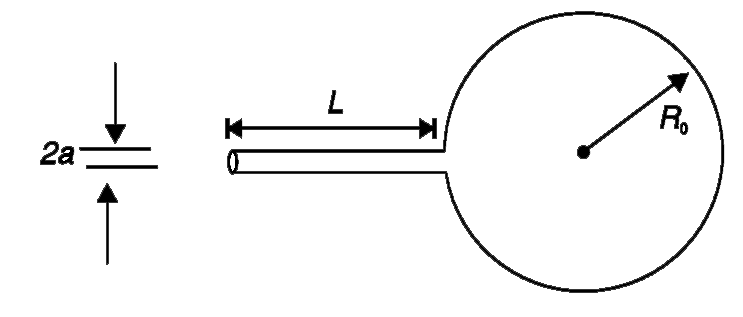A soap bubble is blown at the end of a capillary tube of radius a and length L. When the other end is left open, the bubble begins to deflate. Write the radius of the bubble as a function of time if the initial radius of the bubble was R0. Surface tension of soap solution is T. It is known that volume flow rate through a tube of radius a and length L is given by Poiseuille’s equation- Q=πa4ΔP8≠L

Where ΔP is pressure difference at the two ends of the tube and ≠ is coefficient of viscosity. Assume that the bubble remains spherical.
The correct Answer is:R=R0[1−a4Tt2≠LR40]1/4
Step by step video, text & image solution for A soap bubble is blown at the end of a capillary tube of radius a and length L. When the other end is left open, the bubble begins to deflate. Write the radius of the bubble as a function of time if the initial radius of the bubble was R_(0). Surface tension of soap solution is T. It is known that volume flow rate through a tube of radius a and length L is given by Poiseuille’s equation- Q=(pia^(4)DeltaP)/(8ne L) Where DeltaP is pressure difference at the two ends of the tube and ne is coefficient of viscosity. Assume that the bubble remains spherical. by Physics experts to help you in doubts & scoring excellent marks in Class 11 exams.
Topper's Solved these Questions
Similar Questions
Find the radius of the soap bubble if 44×10−6J of work is done in flowing the soap bubble surface tension of soap solution 7×10−2Nm
View SolutionTwo soap bubbles of unequal sizes are blown at the end of a capillary tube. Which one will grow at the expense of the other end what does it show?
View Solution
Knowledge Check
- Question 1 - Select One
Surface tension of soap solution is 2×10−2N/m . The work done in producing a soap bubble of radius 2 cm is
A64π×10−6JB32π×10−6JC16π×10−6JD8π×10−6J - Question 2 - Select One
A soap bubble is given negative charge then its radius
AdecreasesBincreasesCremains unchangedDnone of these - Question 3 - Select One
The surface tension of a soap solution is 0.05 Nm−1 How much work is done to produce a soap bubble of radius 0.03 m?
A1.8×10−2JB2.1×10−3JC1.5×10−2JD1.1×10−3J
What will be the work done in increasing the radius of soap bubble from r2 to 2r, if surface tension of soap solution is T?
View SolutionThe surface tension of a soap solution is 0.03Nm−1. How much work is done to produce a soap bubble of radius 0.05m
View SolutionThe surface tension of soap solution is 10×10−2 n/m . The amount of work done in blowing a soap bubble of radius 2 cm is
View SolutionA soap bubble is given a negative charge, then its radius
View SolutionA soap bubble has radius r The work done in increasing its radius to three times its original radius, without any rise of temperature, is (Given Surface tension of soap solution is T)
View Solution

